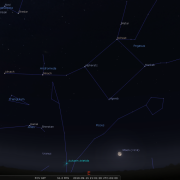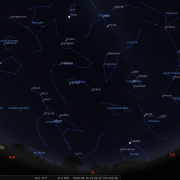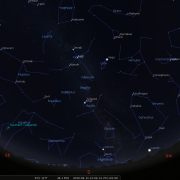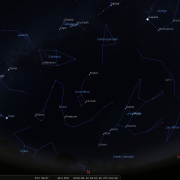Welcome to the WDAS monthly newsletter for September 2019: a digest of the month's latest contributions to our website. Below you'll find Society News; news aplenty past and coming events; a retirement; and, of course, your monthly Sky Notes.
Society News
Well, we tried our best, but it was pretty much in vain. The weather was marginally better than forecast and many Regatta activities went ahead, just not most of ours.
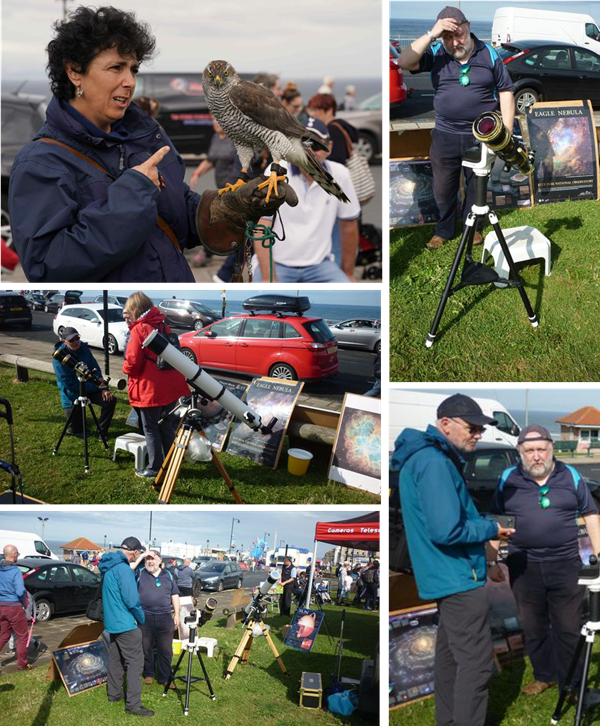
Saturday was rather windy throughout and although a few breaks in the cloud did allow for some brief solar observations in the afternoon, it was certainly not ideal. Barbara and Mark made it along for a while, but we couldn’t even show them any sunspots, completely bare again... the Sun that is.
Suffice to say the gazebo stayed in the car – as did most of the poster boards after a number had made a bid for freedom, and when the deluge arrived late afternoon, so did Keith and Mark, watching people run for cover - broken and twisted brollies in hand... or just running after broken and twisted brollies. You get the picture.
Saturday evening was almost a wash-out, Mark went up to take a rain check, which for a while had ceased allowing a brief glimpse of the moon and Jupiter. No one else was there to marvel at this stroke of luck lasting all of 20 minutes!

Sunday was slightly less windy and as a result more uniformly overcast. Again, very little emerged from the car – a few poster boards, but it was all rather dreary. Phil and Elaine came along to lend moral support and handle a few birds of prey.
At least the Typhoon fighter made the short journey from Lincolnshire putting on a fine and extremely noisy display, making up for the previous day when the sick note read – ‘sorry Ty cannot fly today due to excessive wind’. Sshh don’t let on to the Russians! The Wing walkers were also great to watch.
Conditions for the Sunday evening were forecast to be pretty dreadful, heavy rain and overcast skies. That nights star party, although not officially cancelled was very unlikely to go ahead. The heavy rain failed to materialise and the cloud mostly stayed just to the north of Whitby. For what seemed like a very uncomfortable age the Moon, Jupiter and Saturn all showed their faces, fortunately (as we had just one scope in the car) no one else did!
With no customers Keith and Mark abandoned ship and went to watch the fair ride lorries negotiate their way around the bottom of Khyber Pass – always good for drama and ‘will it or won’t it’ moments. Disappointed nothing was demolished they made their way back to the car, the Moon, Jupiter and Saturn still embarrassingly on view, but no custom either. Cloud did then finally roll up our decision the breeze intensified.
Monday was a tremendous improvement – with good spells of sunshine and little wind. The downside being we don’t normally host anything on the Monday!! .....breathe and count to twenty. But what the heck, we decided to go for it and at least try to salvage something from the weekend. No Gazebo just poster boards and a couple of scopes... including Keith’s Solar scope and ‘cheap mount’... breathe and count to 30... which he’d popped home for during the only rain shower of the afternoon. It was worth it as two solar flares were visible on the limb. Hallelujah, the best observing of the weekend.
Marcus at Grovers Optics – who had endured the whole weekend (but had done some decent trade) was also impressed, celebrating by sticking a golden eagle on his arm!
It had been a funny old Regatta, hopefully we’ll have better fortune next year. That, and some sunspots.
After drawing a blank for Regatta, the following weekend event fared somewhat better with the Saturday evening star party going ahead under reasonably clear skies.
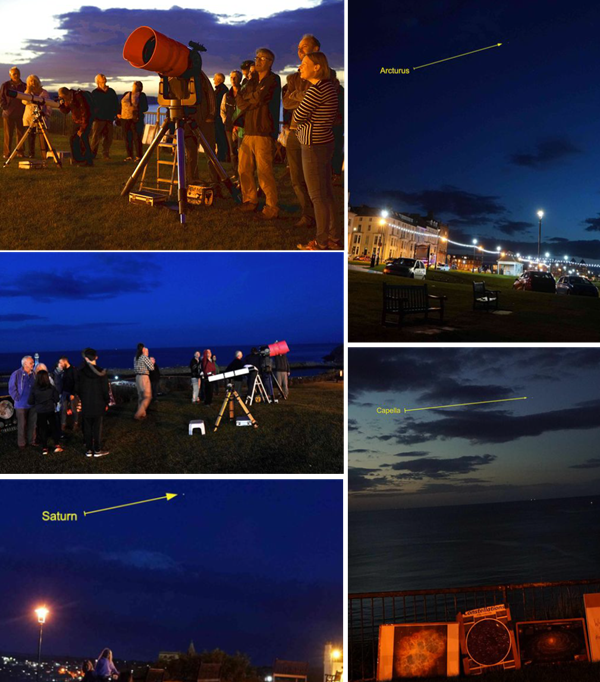
Jupiter and Saturn were naturally the main course, with a waning gibbous moon rising over by the Abbey acting as desert.
Things didn’t all go to plan with the LX 200 refusing to point anywhere near initial set up alignment stars. This meant we couldn’t use the automatic GOTO function and slewing had to done manually, not ideal when you have to continually adjust for objects. The views were still pretty decent, and people loved Saturn.
Another bank holiday weekend and... ‘stone the crows’... another heat wave (what is it about bank holidays and unusually hot weather this year...doesn’t seem right).

The event on the Friday night –Aug 23rd, the final night of folk week, turned out to be quite successful, although it was unusually quiet to begin with. With no LX in service that night, Keith brought his 12” Dobsonian, with Mark bringing up the 6” Dob' and 4” Tal in a separate car journey. John also came up with his 5" Goto scope, so we had enough instruments. Barbara and Mark also made it up after braving the traffic back from Leeds – never good on a bank holiday weekend.
After setting up Jupiter was targeted first, before it dropped behind the Royal Hotel. It was the classic view of Jupiter with the Galilean moons strung out, two either side. Saturn was up next and looked much crisper through the eyepiece than the week before. Seeing conditions were obviously markedly better and much appreciated by everyone present. Titan was clearly visible along with another moon; probably Rhea. Our usual roll call of deep sky wonders then followed and with a steady stream of people coming to view, ask questions and stick around, it was a pleasing evening by anyone standards.
 This has to go down as one of the warmest star party nights we have ever done, still around 23 degrees at 22:30h! It was not a surprise therefore that the west cliff was pretty busy. Keith, Mark and John manned the four scopes deployed, Keith’s 12” Dobsonian, the LX 200, the 6” Dobsonian and John’s 5” SCT.
This has to go down as one of the warmest star party nights we have ever done, still around 23 degrees at 22:30h! It was not a surprise therefore that the west cliff was pretty busy. Keith, Mark and John manned the four scopes deployed, Keith’s 12” Dobsonian, the LX 200, the 6” Dobsonian and John’s 5” SCT.
Mark had spent some time trying to rectify the pointing issue with the LX on the Saturday evening. It was only a partial success and some tracking was possible, but the scope still had to be readjusted every few minutes. At least the public were impressed with the view through the eyepiece. With two large scopes in operation, two journeys were a necessity in order to ferry equipment up, but it worked out okay. Before it was obscured by buildings, John and Keith targeted Jupiter with their scopes, whilst Mark set up the LX. All scopes targeted Saturn, which looked very impressive with two, if not three moons visible.
Quite a crowd gathered round the instruments to get glimpses of the objects targeted, these included the Ring nebula, Dumbbell nebula, Alberio, Vega, Mizar and Alcor and the Andromeda galaxy, all greatly appreciated.
Sky conditions were clear, but some heat haze seemed to help steady seeing, Saturn benefiting in particular.
Despite the issues with the LX, it was a rewarding evening; post 23:00h before we were able to pack things away. We are now seeking a new hand controller for the LX, which we believe may be the cause of the problem, the keys stick anyway.
 Our annual jaunt over to Westerdale is towards the end of September this year on Friday 27th. The start time is 19:00h finishing around 22:00h at the latest. If skies are clear it should be an excellent evening with dark skies and some familiar faces to meet once again. If you are intending on coming along meet at Mark’s for 18:15h.
Our annual jaunt over to Westerdale is towards the end of September this year on Friday 27th. The start time is 19:00h finishing around 22:00h at the latest. If skies are clear it should be an excellent evening with dark skies and some familiar faces to meet once again. If you are intending on coming along meet at Mark’s for 18:15h.
 Booked over a year ago – this will be held (weather permitting) on the Archery Green, West Cliff on Sept 24th from 19:00-21:00h. If cloudy/rainy we will be setting up in the Spa Pavilion for plan B or C. Plan A is to be on the Archery green for 18:45h.
Booked over a year ago – this will be held (weather permitting) on the Archery Green, West Cliff on Sept 24th from 19:00-21:00h. If cloudy/rainy we will be setting up in the Spa Pavilion for plan B or C. Plan A is to be on the Archery green for 18:45h.
We have a number of star party events to look forward to in the Autumn. They include:
- An event for the closing of the ‘Unblinking Eye’ 55 yrs of Space operations at Fylingdales station’ exhibition currently running at the Museum. This will also be held on the Archery Green on Oct 26th – more details next month.
- We have a probable event at Ainthorpe around Oct 18th – (may be at the inn) Details to be finalised – see next month’s notes
- Also in October – date not yet confirmed we have scout/cub visitations. Likely to be early or late October
- Finally, on Nov 2nd we shall be at the Danby Moors Centre for the annual dark sky event.
Monthly Meetings Recommence
WDAS monthly meeting recommence on Tuesday Oct 1st at the usual venue; Caedmon College, Normanby campus room H1 (formally known as Whitby College) from 19:30h. New members welcome.
Sky Notes
In this month's Sky Notes:
- Planetary Skylights
- Meteors (lack of...)
- Comet 2018 W2 (Africano)
- Autumnal Equinox 2019
- September 2019 Sky Charts
Planetary Skylights
Jupiter and Saturn remain the dominant planets throughout September, although they are not the only gas giant planets present in the late evening sky, however Uranus and Neptune will definitely require a telescope just to verify them as anything other than faint stars.

Located quite low to the SW in the Southern-most reaches of Ophuichus, Jupiter requires minimal magnification to discern its bright ‘sixpence’ like disk through the eyepiece. Observations will be compromised somewhat due to the low altitude, but during moments of good ‘seeing’, Jupiter is a wonderful target. Look for the ‘belts’ and Great Red Spot (when visible) as well as the Galilean moons, seen as bright specks of light in vicinity of Jupiter, presenting a different configuration each night. By the end of September Jupiter is setting before 20:30h so make the most of any observing opportunities. The Moon lies closest to Jupiter on the 6th.
Because the period in which to observe Jupiter is diminishing as it nears the end of its apparition, the following Great red spot visibility times are all for 20:00-21:00h BST:
- 1st, 3rd, 8th, 13th, 18th, 20th, 23rd, 25th, and 30th.
Galilean moon shadow transits also visible 20:00-21:00h.
- 4th: Europa shadow transit
- 6th: Io shadow and moon transit
- 22nd: Io shadow transit (20:15h)
Top: 05-Sep-2019 at 20:45h Looking South: Saturn, The Moon and Jupiter
Bottom: 08-Sep-2019 at 21:00h Looking South: Saturn and The Moon
(Click picures for full-sized image)

 Following Jupiter across the South, Saturn is now best placed for observations at a convenient hour. Resembling a fairly bright pearly star of magnitude Mag +0.2, Saturn resides above the South horizon in the constellation of Sagittarius. Suffering from the same ‘unsteady seeing’ problem as Jupiter, your patience at the eyepiece will ultimately be rewarded with the ring system evident in modest telescopes. The two main rings A and B are the most evident separated by the Cassini ‘gap’. Look also for Saturn’s largest moon; Titan, visible as a speck of light nearby. Our Moon lies in proximity to Saturn in the sky on the 8th.
Following Jupiter across the South, Saturn is now best placed for observations at a convenient hour. Resembling a fairly bright pearly star of magnitude Mag +0.2, Saturn resides above the South horizon in the constellation of Sagittarius. Suffering from the same ‘unsteady seeing’ problem as Jupiter, your patience at the eyepiece will ultimately be rewarded with the ring system evident in modest telescopes. The two main rings A and B are the most evident separated by the Cassini ‘gap’. Look also for Saturn’s largest moon; Titan, visible as a speck of light nearby. Our Moon lies in proximity to Saturn in the sky on the 8th.
 Neptune reaches opposition this month (10th) residing in the constellation of Aquarius close by the star Phi aqr. You will require a telescope to spot its diminutive disk, which is fainter than all visible naked eye stars, but it does appear decidedly blue grey in hue. If skies are clear on the 6th and 7th, Neptune lies right next to Phi aqr and if you have a 10” scope or larger you should be able to pick out Triton, Neptune’s largest moon between it and phi aqr.
Neptune reaches opposition this month (10th) residing in the constellation of Aquarius close by the star Phi aqr. You will require a telescope to spot its diminutive disk, which is fainter than all visible naked eye stars, but it does appear decidedly blue grey in hue. If skies are clear on the 6th and 7th, Neptune lies right next to Phi aqr and if you have a 10” scope or larger you should be able to pick out Triton, Neptune’s largest moon between it and phi aqr.

06-Sep-2019 2100: The Moon, φAquarii (the star), Triton, Neptune.
 Uranus resides in the Southern reaches of Aries, and is best observed later in the night when higher to the south, but you will find it above the east horizon at 22:00h forming a triangle with Torcular in Pisces and Al Kaff al Jidmah I in Cetus. Look for a small grey green disk.
Uranus resides in the Southern reaches of Aries, and is best observed later in the night when higher to the south, but you will find it above the east horizon at 22:00h forming a triangle with Torcular in Pisces and Al Kaff al Jidmah I in Cetus. Look for a small grey green disk.


 Mars, Mercury and Venus are all lost in solar glare this month.
Mars, Mercury and Venus are all lost in solar glare this month.
Meteors

No notable meteor showers this month. Sorry everyone!
Comet 2018 W2 (Africano)
This comet will not be a naked eye object, but should be visible in binoculars or small scopes. It is also well placed for northern hemisphere observers, tracking through Perseus, Andromeda and Pegasus during September.
The comet reaches perihelion (closest to sun) on Sept 6th when around 5 degrees below the double cluster in Perseus. At an estimated magnitude of +10.5, it will then track down through Andromeda, passing through the bottom left-hand quadrant of the Square of Pegasus by the 26th, when it may be a magnitude or two brighter. Yep, not spectacular, but you never know with comets.
Autumnal Equinox 2019
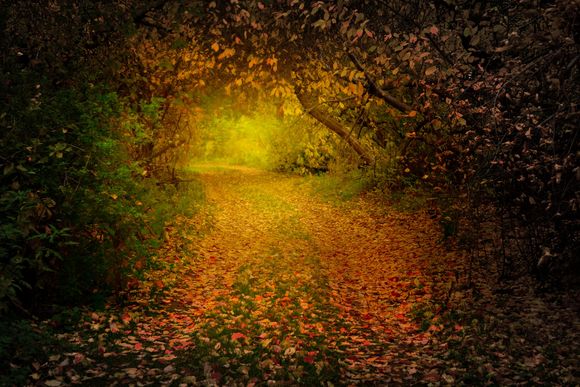
By astronomical convention autumn officially commences in the northern hemisphere on the date of the Autumnal Equinox, when from our perspective the Sun re-crosses the celestial equator and heads south, arcing ever lower above the south horizon.
This year the date of the equinox again falls on September 23rd. For the second time in its orbit around the Sun, neither of Earths poles is inclined towards our nearest star with hours of daylight and darkness almost equal across the whole planet. As the northern hemisphere continues to tilt away from the Sun, evenings will rapidly draw in once again as we head toward winter. Cheery thought!
September 2019 Sky Charts
|
Looking North
Mid-September - 21:00h |
Looking South |
|
Looking East
Mid-September - 21:00h |
Looking West
Mid-September - 21:00h |
|
Northern Aspect
Mid-September - 21:00h |
Southern Aspect
Mid-September - 21:00h |
| Looking North (Early) Mid-September - 04:00h |
Looking South (Early) Mid-September - 04:00h |
Additional Image Credits:
- Planets and Comets where not otherwise mentioned: NASA
- Sky Charts: Stellarium Software
Events
 Observe the night sky with us at the Bruce Observatory, Whitby School
Observe the night sky with us at the Bruce Observatory, Whitby School
Observing Nights are held weather permitting: check for a relatively clear sky before leaving home. If in doubt, Mark can be reached on 07886069339
Please note the college drive gate is now operated via a electronic key code - so anyone wishing to attend must be at the car park at the top of the drive by 19:00hrs - unless an arrival time has been arranged with Mark/Keith.
 Observe the night sky with us at the Bruce Observatory, Whitby School
Observe the night sky with us at the Bruce Observatory, Whitby School
Observing Nights are held weather permitting: check for a relatively clear sky before leaving home. If in doubt, Mark can be reached on 07886069339
Please note the college drive gate is now operated via a electronic key code - so anyone wishing to attend must be at the car park at the top of the drive by 19:00hrs - unless an arrival time has been arranged with Mark/Keith.







